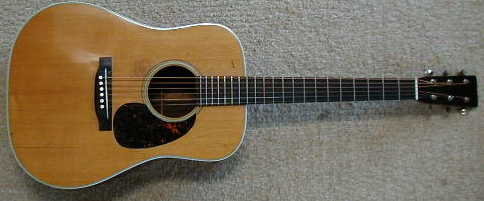
The "Modzilla" D-28

Jump to Updates:
The now-"Modzilla D-28" started out as a 1973 Martin D-28 and was my first "real" guitar. In 1979, I'd been flatpicking for about a year and decided it was time to move up to a Martin. At the time I didn't know anything about Brazilian rosewood or the ins and outs of various Martins. I scanned Frets and Bluegrass Unlimited for every tidbit I could find and about all I could determine was a lot of people played Martin D-28's. I also knew that I liked the "Martin" script on the headstock better than the mother of pearl inlaid "Martin". That's a good thing, because the MOP inlay belongs to 40 level instruments and up, none of which I could afford! None of the shops in Lexington, KY had any Martins in stock, certainly none I could afford, so I started watching the want ads. One day, there it was: "Martin D-28. $750. call....". Well, I didn't have $750, but I did have an extra dirt bike. I stuck the ad in my wallet and set out to sell the dirt bike. A few weeks later, I had $650 cash and I called the number. "Still got the D-28?". "Yup". The lowest he'd go was $690 so a banjo playing friend and I drove out to his place. The guy was a preacher and had just a house full of instruments! And the reason he was selling the D-28 was because he'd just bought a Martin with that ugly MOP inlay on the headstock.... I ended up borrowing $40 from the banjo player and getting the D-28. I thought that was IT and I'd never, ever, ever possibly want another guitar! Ha, ha.
At the time I bought it, the D-28 was in pristine condition, but that didn't last long. During the 2nd week that I had the guitar, I sat down to play and swung my left foot up on my right knee. I had on hiking boots (waffle stompers...) and being young and limber, over-swung and the boot just tapped the guitar top. Craaaackkkkk! I'd just put my first crack in the top, a lovely 6" number. No use crying over Humpty Dumpty, so I just looked at it and continued playing.
After a year or so, I discovered that the intonation was off. My guitar teacher at the time recommended a shop, so I took it to them. Instead of actually correcting the intonation, they merely dressed the frets and lowered the action, thus making the guitar very hard to play (due to low frets) and also becoming the first luthier to perform a less-than-accurate diagnosis and repair. In 1980, I headed off to South Plains College to start in the bluegrass music program there and the D-28 (my only guitar!) went along. While there, under the influence of another guitar player- JR Girod (JR- where are you!?)- I had the next to last fret inlaid with my initials so as to identify it as mine and also so I'd never be tempted to sell it. While I liked the guitar a lot, it seemed like every other guitar played better and easier than mine did, but no one could tell me why. While at SPC, I started getting some finish cracks. We'd go most Saturdays to local jamborees with the instruments usually riding in the back of my pickup truck. At one, it was pretty cold, but I was in a hurry to get my guitar out and impress a cute little girl, so I didn't wait for it to warm up. Craaaaacckkkkkkk! Finish crack city! Oh well, now it looked old.
After SPC, I went to college at New Mexico State and continued to slog along on the D-28. In 1983, at the recommendation of fellow SPC student and now legendary fiddler, Stuart Duncan, I shipped the guitar off to Frank Ford for a brace scalloping job. Soon after, I replaced the plastic bridge pins with ebony. Both changes helped the sound, making it more open and giving it wider dynamic range. I still struggled with the playability, though, and didn't have either the money or knowledge to figure out why it wasn't playing well. I thought it was just me and that I was a sloppy player and just needed to practice more.
In 1985, I visited my friend and famous cowboy poet Buck Ramsey. Buck let me play his 1957 D-21 and, as I was leaving, said "Take that guitar home with you!". I left my D-28 with him. Well, I tell you what- my playing improved immediately, dramatically, and literally overnight as a result of Buck's guitar. Suddenly I realized that it really might not be me, but the guitar that was at fault. I played Buck's guitar for almost 2 years before swapping back. When I picked up mine, Buck had put a lot more finish cracks in it and, worse, tried to clean them out with furniture polish! This resulted in stained finish cracks. I wasn't too worried about it, since I still didn't have much respect for the guitar. I did notice right away, though, how much smoother and mellower my D-28 sounded. The rhythm sound was superb and it was only on leads that it didn't have "bark". But, man, did it play like a brick! At this point, I got totally frustrated with the D-28 and just put it in the closet for nearly 2 years while I played my new Squier Stratocaster. Finally, my wife and I got out of school, started working and making a little of money, and I decided to either get the D-28 playing right or sell it. I'd been disappointed too many times by luthiers with their own agendas and little knowledge of how a bluegrass flatpicking guitar really should work and this time I decided to do my research.
ca. 2000- A closeup shot of the finish cracks- there's probably not a square inch that doesn't look like this!
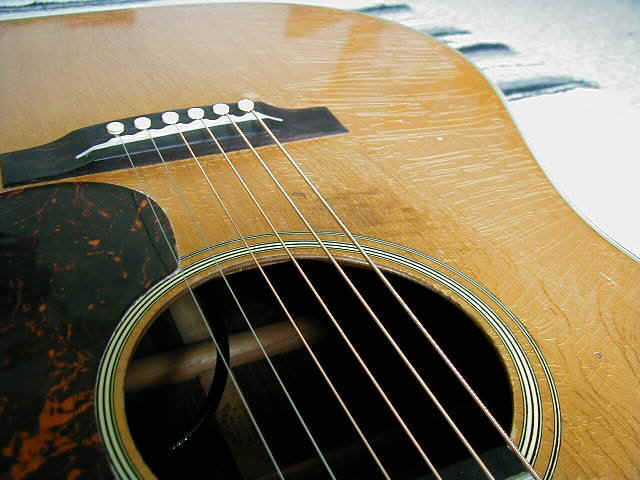
The search for a luthier began in 1990. I knew what was wrong with the guitar- the intonation was off and it was hard to play, but instead of going to the luthier and telling them that, I’d just hand them the guitar and see what they said. I’d mention the players I listened to. Most would say "Tony who?" and recommend anything from a neck reset to a fret job to "It feels fine to me" to a new guitar. I’d say "Oops, I gotta go!". Finally, one guy said "Ahh…I love "Manzanita"!" He measured a few things on the guitar and said "I bet it plays hard and it’s out of tune". This luthier was Craig Anderson, formerly of Santa Fe, now making custom guitars in NYC. I left the guitar with him and he moved the saddle slot back, changed the Grover Rotomatic tuners, refretted it, and radiused the fretboard back to stock (it was dead flat and that was the first I’d heard that fretboards even HAD a radius!). When I got it back, it was great!! Craig was the first guy to make it play.
I pretty much left the guitar alone for the next 5 years. But then I bought a HD-28 for a friend. This guitar had an enlarged soundhole and sounded pretty good! I got to thinking about doing this to my guitar and finally decided that the value was pretty well shot with the modifications already done, so I got out some sandpaper and went to it! Immediately I noticed a more biting sound and I, as a player, could hear the guitar a LOT better. I was starting to like my guitar! But the neck still didn’t seem quite right- it was good, but other guitars STILL seemed easier to play. By now it was 1994, I was actually working, my falconry book was out, and for the first time in my life, getting another acoustic seemed like a possibility. By now, I'd played enough other guitars to know that my D-28 sounded great, but just played hard. I decided that I wanted a Martin D-28 "1935 Reissue", found one, and bought it. Now I had a perfectly stock Martin to use as a comparison and standard. I started exploring and measuring things instead of just going by "feel" and this was the start of my lutherie career.
This is the Modzilla mid-modification. Note the orginal neck with BAK inlaid, 1st replacement pickguard, and original short-saddle bridge. Soundhole is "half-Tony".
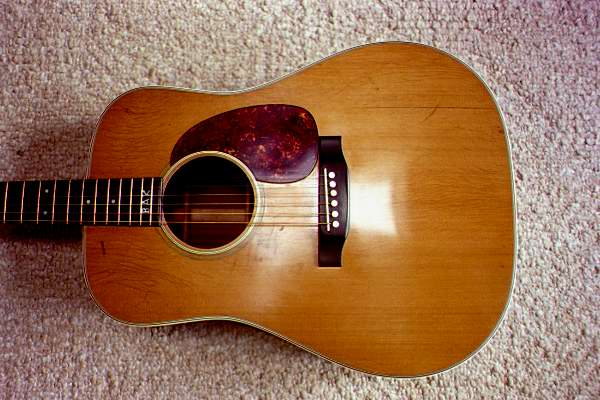
In 1996, we moved to the ranch in New Mexico and suddenly I had both time and room to really concentrate on what made one guitar play well and another play poorly. I started buying lutherie tools and reading and asking questions. Eventually, I found out that the radius on the D-28 was not even. The bass side was 16", but it curved down to 12" on the treble sides. Later, I found out that this is a common trick in setting up electric guitars and then I remembered that I’d asked Craig to set it up just like my Strat’s neck. While this may work on electric, on the D-28 it always felt like I was having to reach a little deeper for the treble strings and it would throw me off. I also discovered that my D-28’s neck was 1 10.5/16" wide, making it a skinny feeling neck. I’d also been playing the D-28 1935 Reissue and I knew now that I liked wider 1 ¾" necks. I also knew that the soon-to-be "Modzilla" D-28 needed a neck reset and so I decided to just replace the whole neck with a vintage width one. Luthier’s Mercantile started selling CNC’ed vintage neck replicas, and I bought one, along with a truss rod, fretboard and etc. This really began my serious luthier tinkering! After a couple of false starts and botched attempts I got the neck on to my satisfaction (then!) and immediately realized that I was going to need a new bridge with wider spacing to go along with the new wider neck. Seems obvious now!
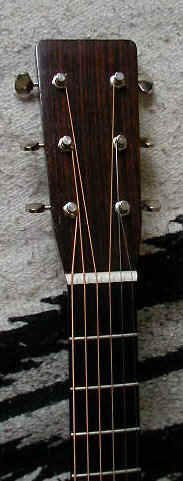
The Modzilla's headstock.
I also tried bolting the neck on like Collings (I’d just bought my Collings CW). Along with this, I discovered the "popsicle" brace and all the sound improvement claims that go along with not having it. So, I removed that, too! My first bridge was awful. It was too thick and not cut far enough into the wings. After having the guitar together and playing for about 6 months- and it sounded pretty good, but not killer yet- I was at a jam in the Pecos, NM. In between songs, I rested my arm on the neck and heard a little "pop". "Strange", I thought. So I did it again. POP! The neck was coming off! I loosened the strings and put it up. Later, I found out that while bolts will provide good stability along the string’s plane, they do nothing for side-to-side stresses. I’d installed the neck with a really sloppy dovetail, trusting the bolts to do the work. By now, I’d learned a lot more about working on guitars, so I took the neck off again (it was already off!), got a tight fitting dovetail and glued it back together. I also removed the large rosewood bridgeplate and glued in a smaller maple one. A few weeks later, the neck was doing fine, but I noticed some bellying which hadn’t been there before. Attributing this to a too small bridgeplate, I removed the one I’d just installed and put in a slightly larger one. Still bellying with medium gauge strings…I really don’t spend all my waking hours studying this guitar, especially with a Collings Clarence White in the house, so I just loosened the strings and put it in the closet for a later date. When that later date came, I discovered a loose brace. It probably had loosened it while removing the bridge plate the first time. I glued it back down and strung it back up. No belly.
As I mentioned earlier, my first bridge was pretty clunky. Plus, I’d used Titebond for all my repairs. I'd discovered Luthier Mercantile’s white glue and wanted to test it. LMI’s glue dries hard and seems to really transmit sound well, plus it’s an aggressive glue. I didn’t really like the idea of having a sheet of vinyl (which is basically what Titebond is) between my bridge and top, so I went ahead and pulled off the bridge. This time, I shaped the bridge a LOT better, got the bottom nice and flat, shaved off the wings more and glued it down with LMI’s glue. All this made a very noticeable difference in the guitar’s response and gave it a very crisp sound. Prior to this, I’d scalloped the saddle and nut, and by reshaping the bridge with the saddle glued-in, I got a perfect looking fit.
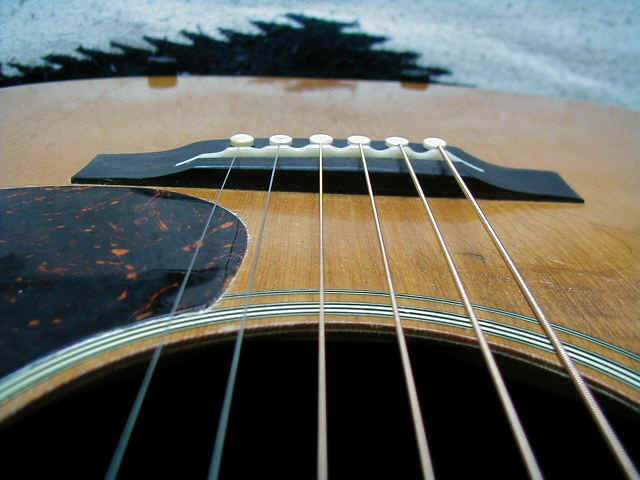
The reworked bridge as of June 2000.
Somewhere alone the way, I also replaced my original Kluson copy tuners with some Gotoh’s with scalloped buttons. I went thru 2 pickguards before settling on a "40’s style" Deep River pickguard.
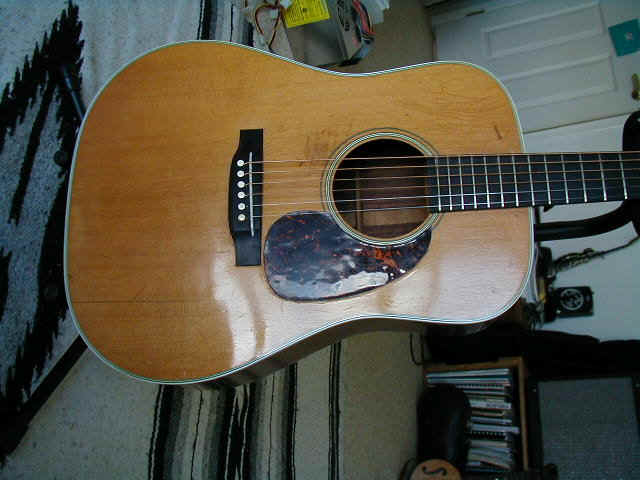
At that time, the "Modzilla" D-28 sounded great. Compared to my (edit: former) Collings CW, it was louder, especially in the bass, and had a very powerful mid-range sound. It’s not quite as clear as the Collings, but it's awfully close and it puts out an incredible rhythm sound with thick chords. The big neck is terrific for playing standing up, being very forgiving and easy to hang on to. I’ve played it at several jams now and I always get comments like "That guitar sounds great!" with the next comment invariably being "What is it?". I like to call is a W.A.S. Martin. Someday, I’ll inlay something tasteful on the headstock, but until I’ll just keep playing it! It’s been a long bumpy road for this guitar, but boy have I learned a lot from it!
Time to upgrade the Modzilla's page!! I've done several things to the guitar since the above was written. For starters, I took the neck, bridge, and bridgeplate off again, to re-glue them with hide glue. While all this was apart, I worked on the neck angle again and installed a Brazilian rosewood bridge instead of the usual ebony one. And finally, I opened the soundhole up to "Full Tony"- 4 9/16".
While I had the bridge and plate off, I decided to patch all the old holes. I did this by cutting out a section of the top and inlaying a new piece of spruce. The edges of the patch are beveled for more gluing surface.
Here's what it looked like before I started. Dowels and plugs everywhere.
Getting the patch sized
Patch in place.
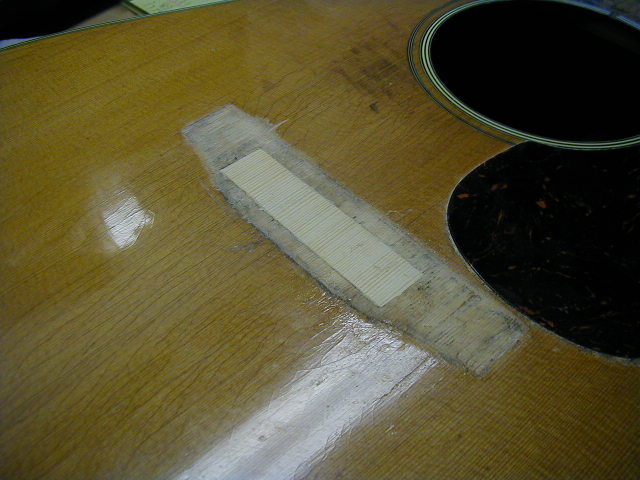
This is the Brazilian rosewood bridge. Spacing is 2 3/8" center to center.
Closeup of the top
The top crack
Overall shot of the body
The back
This is what "reverse shims" look like. I've used these on customer's guitars from time to time to correct an over-aggressive (not mine!) neck reset. These are a little more obvious than some I've done.
The guitar still sounds great! The Brazilian RW bridge really brought the treble and snap out, more than it's ever been before. Here's a You Tube video of me playing the guitar.
----------------------
I've made a few more changes to the Modzilla!. When I originally put the new neck on, I used an Indian RW faceplate that was kind of plain. Early in '09, I decided to replace it with a nicer looking one. I took pictures of most of my faceplates and let the members of Flatpick-L help me pick a new. Here's the result:
While I was at it, I replaced the closed back "cookie-cutter" Kluson copies with open back, flat-based Gotohs and went for the gold (I had them laying around already).
And here's the Brazilian RW bridge as it appears today. Pins are black water buffalo. I recut the slot in '04, making it a little deeper.